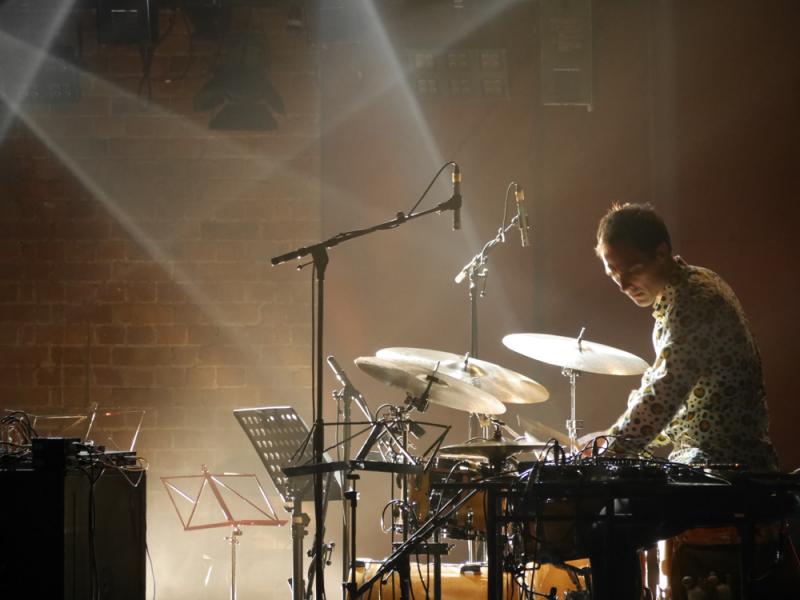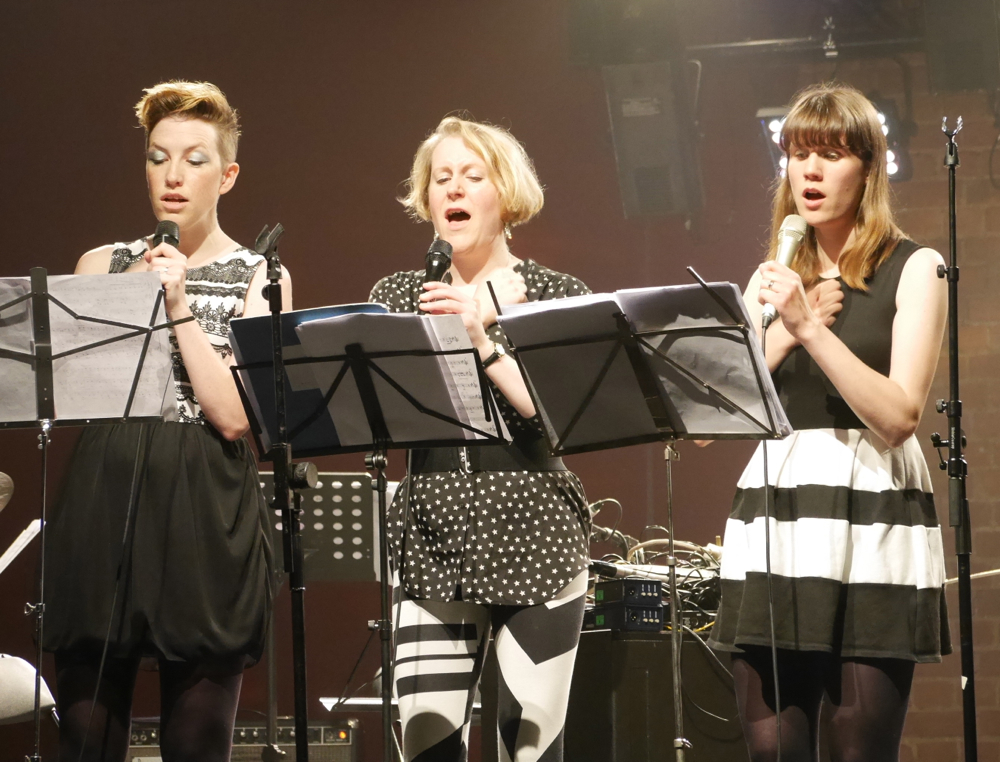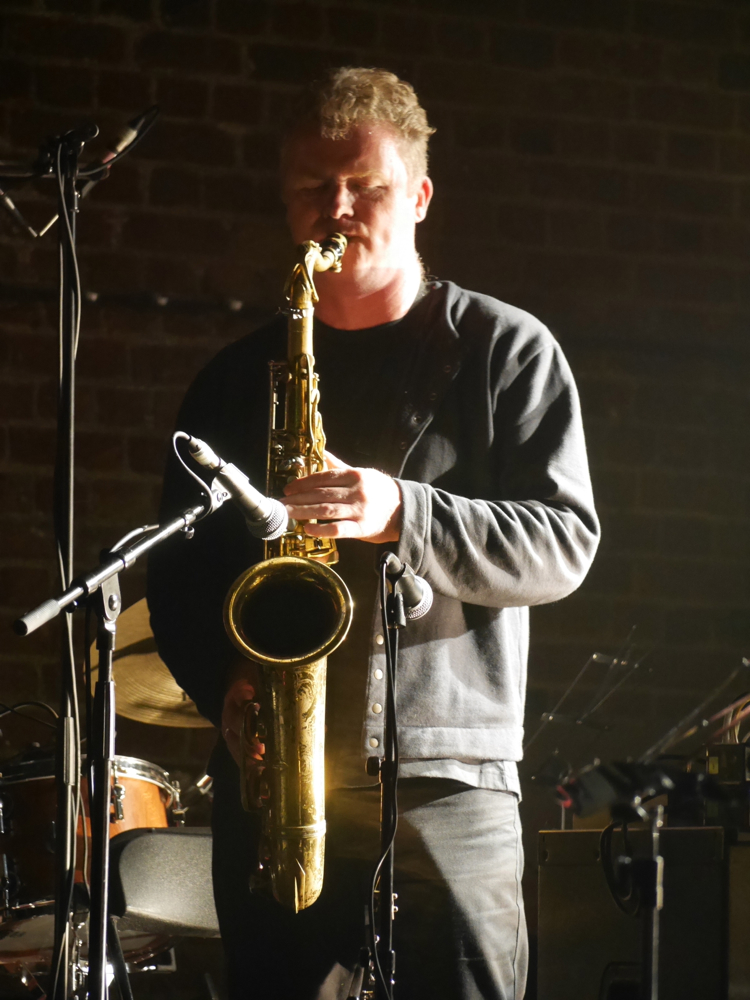Emulsion III, Village Underground | reviews, news & interviews
Emulsion III, Village Underground
Emulsion III, Village Underground
Theatrical use of space exalts jazz-classical festival to greatness

The third Emulsion Festival, curated jointly this year by Trish Clowes and Luke Styles, turned out to be more of a collage of original colours, when the second day of programming concluded at Village Underground last night.
The Village Underground itself was the other star of the evening. Its soaring vertical space, sheer brick surfaces and transept-like alcoves have never felt quite so much like a secular cathedral. Opening the concert with a piece for unaccompanied bass, Calum Gourlay filled the space with a combination of spinning bass beats and a virtuosic exploration of harmony evoking Bach. The placement of his instrument, dwarfed by the caverns above the stage, was a theatrical coup, its physical insignificance in stunning contrast to the resonant spirituality of the sound.
 Juice, a (mostly) unaccompanied female vocal trio, played the first full set, a blend of original commissions and their own arrangements of pop songs, including the Rihanna piece. Technically capable of both angular contemporary classical pieces and gooey extruded pop lyrics, their covers are stripped of familiar saccharine arrangements, to create a completely revitalised arrangement that revels in the naked beauty of human voice.
Juice, a (mostly) unaccompanied female vocal trio, played the first full set, a blend of original commissions and their own arrangements of pop songs, including the Rihanna piece. Technically capable of both angular contemporary classical pieces and gooey extruded pop lyrics, their covers are stripped of familiar saccharine arrangements, to create a completely revitalised arrangement that revels in the naked beauty of human voice.
They concluded their set with Luke Styles’ piece “The Girl Who Wishes to Marry Stars”, for Juice and a small ensemble, and due, for their next performance at the Southbank Centre, to have three dancers to add visual theatre. It’s not, as the name suggests, set in a Manchester footballers’ bar, but was adapted from a native Canadian folk tale, and Styles balances the trio’s gorgeous swooping textures with economical, poignant five-piece instrumentation to tell the bittersweet tale (real stars are no better marriage prospect that footballers, it turns out) with irresistible panache.
 Food, a duo of saxophonist Iain Ballamy and drummer Thomas Strønen, came next. Their improvised, trance-like exploration of rhythm and texture was given theatrical heft by the setting, the two men isolated in space, like ceremonial priests in a maze of lights and smoke. Both players have a desk of loops and effects as well as acoustic instruments; both experiment with the softest acoustic sound, as well as brain-curdling rhythmic loops. Now signed to ECM, Ballamy’s acoustic playing has moments of likeness to his ECM colleague Jan Garbarek, though that smoothness is not the primary aesthetic, and is quickly obliterated by one of Strønen’s depth charges.
Food, a duo of saxophonist Iain Ballamy and drummer Thomas Strønen, came next. Their improvised, trance-like exploration of rhythm and texture was given theatrical heft by the setting, the two men isolated in space, like ceremonial priests in a maze of lights and smoke. Both players have a desk of loops and effects as well as acoustic instruments; both experiment with the softest acoustic sound, as well as brain-curdling rhythmic loops. Now signed to ECM, Ballamy’s acoustic playing has moments of likeness to his ECM colleague Jan Garbarek, though that smoothness is not the primary aesthetic, and is quickly obliterated by one of Strønen’s depth charges.
The final set comprised a series of original commissions for the Emulsion Sinfonietta (the evening’s combined forces plus guest trumpeter and violinist). Writing convincing jazz-influenced orchestral music has challenged composers as distinguished as Ellington and Shostakovich: the formal demands of jazz and the orchestra sometimes pull in different directions, and it’s hard to sound so original working with a traditional ensemble. Yet these were all charismatic pieces of orchestral writing, with, in several cases, such as Ballamy’s “Golden Acre”, and Clowes’ “Apple Boy”, an unexpected pastoral theme, emphasised by the Holst-like use of oboe and violin. Guitarist Chris Montague, meanwhile, opted for an American pastoral, giving his piece “Beamish” the jangling guitar lines of Bill Frisell.
Last year’s Emulsion Festival was held at Kings Place, which looked, on paper, like a more obvious venue for this one. The way the Village Undergound space was imagined as an integral feature of the show vindicated that decision absolutely, though it might perhaps have been easier to draw a substantial crowd to Kings Place, where audiences are more used to a playfully ambiguous approach to the generic boundaries of classical and jazz.
At least the concert was recorded for Radio 3, who divided it, appropriately, between their contemporary jazz and classical shows, Jazz on 3 and Hear and Now. Those audiences are in for a treat, though they’re missing the brilliant, three-dimensional theatricality of the live show that made it explode into life in the mind.
rating
Buy
Explore topics
Share this article
The future of Arts Journalism
You can stop theartsdesk.com closing!
We urgently need financing to survive. Our fundraising drive has thus far raised £49,000 but we need to reach £100,000 or we will be forced to close. Please contribute here: https://gofund.me/c3f6033d
And if you can forward this information to anyone who might assist, we’d be grateful.

Subscribe to theartsdesk.com
Thank you for continuing to read our work on theartsdesk.com. For unlimited access to every article in its entirety, including our archive of more than 15,000 pieces, we're asking for £5 per month or £40 per year. We feel it's a very good deal, and hope you do too.
To take a subscription now simply click here.
And if you're looking for that extra gift for a friend or family member, why not treat them to a theartsdesk.com gift subscription?
more New music
 The Last Dinner Party's 'From the Pyre' is as enjoyable as it is over-the-top
Musically sophisticated five-piece ramp up the excesses but remain contagiously pop
The Last Dinner Party's 'From the Pyre' is as enjoyable as it is over-the-top
Musically sophisticated five-piece ramp up the excesses but remain contagiously pop
 Moroccan Gnawa comes to Manhattan with 'Saha Gnawa'
Trance and tradition meet Afrofuturism in Manhattan
Moroccan Gnawa comes to Manhattan with 'Saha Gnawa'
Trance and tradition meet Afrofuturism in Manhattan
 Soulwax’s 'All Systems Are Lying' lays down some tasty yet gritty electro-pop
Belgian dancefloor veterans return to the fray with a dark, pop-orientated sound
Soulwax’s 'All Systems Are Lying' lays down some tasty yet gritty electro-pop
Belgian dancefloor veterans return to the fray with a dark, pop-orientated sound
 Music Reissues Weekly: Marc and the Mambas - Three Black Nights Of Little Black Bites
When Marc Almond took time out from Soft Cell
Music Reissues Weekly: Marc and the Mambas - Three Black Nights Of Little Black Bites
When Marc Almond took time out from Soft Cell
 Album: Mobb Deep - Infinite
A solid tribute to a legendary history
Album: Mobb Deep - Infinite
A solid tribute to a legendary history
 Album: Boz Scaggs - Detour
Smooth and soulful standards from an old pro
Album: Boz Scaggs - Detour
Smooth and soulful standards from an old pro
 Emily A. Sprague realises a Japanese dream on 'Cloud Time'
A set of live improvisations that drift in and out of real beauty
Emily A. Sprague realises a Japanese dream on 'Cloud Time'
A set of live improvisations that drift in and out of real beauty
 Trio Da Kali, Milton Court review - Mali masters make the ancient new
Three supreme musicians from Bamako in transcendent mood
Trio Da Kali, Milton Court review - Mali masters make the ancient new
Three supreme musicians from Bamako in transcendent mood
 Hollie Cook's 'Shy Girl' isn't heavyweight but has a summery reggae lilt
Tropical-tinted downtempo pop that's likeable if uneventful
Hollie Cook's 'Shy Girl' isn't heavyweight but has a summery reggae lilt
Tropical-tinted downtempo pop that's likeable if uneventful
 Pop Will Eat Itself's 'Delete Everything' is noisy but patchy
Despite unlovely production, the Eighties/Nineties unit retain rowdy ebullience
Pop Will Eat Itself's 'Delete Everything' is noisy but patchy
Despite unlovely production, the Eighties/Nineties unit retain rowdy ebullience
 Music Reissues Weekly: The Earlies - These Were The Earlies
Lancashire and Texas unite to fashion a 2004 landmark of modern psychedelia
Music Reissues Weekly: The Earlies - These Were The Earlies
Lancashire and Texas unite to fashion a 2004 landmark of modern psychedelia

Add comment